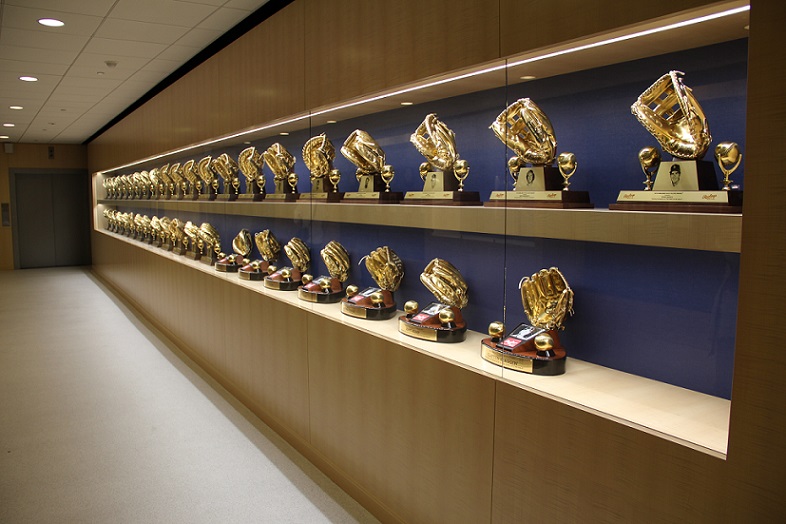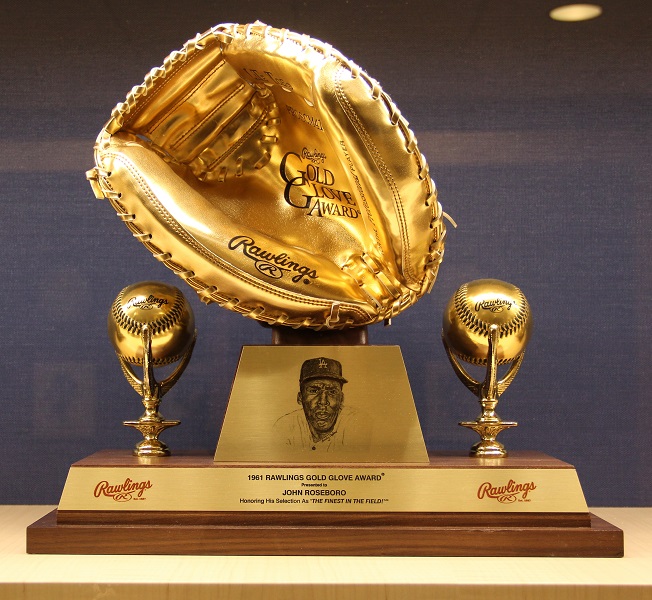Early Friday morning the 2013 Rawlings Gold Glove Award nominees were announced. Among those nominated were five Dodgers: Juan Uribe, Mark Ellis, Adrian Gonzalez, A.J. Ellis and Zack Greinke. The Dodgers five nominees are the most of any National League team and second only to the six Baltimore Orioles to be nominated.
It’s hard to argue that Uribe, Greinke and even Mark Ellis are not deserving of a Gold Glove (although I probably would have had Clayton Kershaw ahead of Greinke), however it is difficult for me to honestly say that first baseman Adrian Gonzalez and catcher A.J. Ellis are deserving of Gold Gloves at their respective positions. Gonzales made more errors at first base (11) in 2013 than ever before in his 10-year MLB career (which includes three previous Gold Gloves), and A.J. Ellis allowed more balls to get past him (6 passed balls and 45 wild pitches) than Yadier Molina (3-22) and Buster Posey (3-33) – and this isn’t counting the devastating passed ball that Ellis allowed in Game-2 of the NLCS that ended up costing the Dodgers the game.

There have been 41 Dodgers to win Gold Gloves since Rawlings began presenting them in 1957. They are proudly displayed on the Dugout Level at Dodger Stadium as you exit the elevators. (Photo credit – Ron Cervenka)
Unlike most other annual awards, the Gold Glove Awards are voted on by managers and coaches with the stipulation that they cannot vote for someone on their own team. And while this may give the Gold Gloves a bit more credibility than those awards voted on by members of the Baseball Writers Association of America (BBWAA), whose voting members are like Supreme Court justices (i.e – the’re in for life with many who no longer cover baseball at all), having managers and coaches voting for the Gold Glove winners has its own built-in flaws.
While it may be fair for managers and coaches in one division to vote on players in their own division whom they see 18 times a season, is it fair for them to vote for players from the other two divisions who they may only see six times a season and perhaps not at all in the case of pitchers? This is a very difficult question to answer, but in all honesty it is still better than the BBWAA voting on the Gold Gloves (in my opinion, that is).
So how did this highly sought-after and prestigious award come to be? I think you will find it’s history both interesting and controversial.
In 1956, a survey was conducted of all MLB players and it was found that 83 percent of them used Rawlings’ gloves. As a result of the survey, Rawlings advertising, PR and sales manager Elmer A. Blasco decided to sponsor a fielding award similar to the Silver Bats Award (more commonly called the Silver Slugger Award) presented annually by Hillerich & Bradsby, the MLB’s leading bat supplier, to the best hitter at each position in the MLB.
Blasco put his plan into action in 1957 when a panel of 19 noted sportswriters voted on who they believed was the best fielder at each position in all of baseball. The results were published in the December 18, 1957 edition of The Sporting News and the Rawlings Gold Glove Award was officially born. The following season (1958) the award was expanded to include the top fielder at each position in both the National and American Leagues.
For the first four seasons of the awards (1957 to 1960), individual awards were presented to each outfield position, however this was changed in 1961 to include three outfielders regardless of their specific outfield position. This remained in effect until 2010 when, amid criticism that each outfield position is distinctly different, the decision was made to return to one award for each respective outfield position in 2011, as it remains today.
Further criticism of the annual awards is that Gold Glove voters frequently count only errors to determine winners and that a players past reputation (in winning the award) sometimes gives them an edge for future awards. The Associated Press once wrote that “some fans have viewed the Gold Gloves as mostly a popularity contest, even suggesting that a player’s performance at the plate helped draw extra attention to his glove.” I have to admit that it is difficult to argue this point.
Soon-to-be first ballot Hall of Famer (and quite possibly first-ever unanimous vote getter) Greg Maddox has won more Gold Gloves than any player in MLB history with 18. This includes a run of 13 consecutive awards from 1990 to 2002. Maddux won Gold Gloves with the Dodgers in 2006 and 2008, with the latter being the last in his remarkable 23-year career. Hall of Fame third baseman Brooks Robinson and pitcher Jim Kaat are tied for second with 16 Gold Gloves each. Incredibly, Kaat won his 16 Gold Gloves consecutively.
The list of former Gold Glove Award winners is very impressive and a virtual ‘who’s who’ of some of the best who have ever played the game; but keep in mind that the award didn’t even begin until baseball was nearly 100 years old and there are thousands who played the game prior to 1957 who undoubtedly would have won numerous Gold Gloves. (Jackie Robinson, Pee Wee Reese and Duke Snider, to suggest only three).
As for the actual trophy itself, it is created from a glove made from gold lamé-tanned leather and affixed to wood base made of cherry. The base is 17 inches wide, 12 inches deep and 2 ½ inches tall. The trophies are absolutely beautiful.

If the winning player uses a Rawlings glove, his Gold Glove is the exact model of glove that he uses; otherwise, a generic glove is used. Pictured here is the first of two Gold Gloves won by former catcher and Dodger legend John Roseboro. (Photo credit – Ron Cervenka)
The 2013 Rawlings Gold Glove winners will be announced on Tuesday evening, October 29 at 5 PM (PT) on ESPN2.




 October 26th, 2013 at 6:00 am
October 26th, 2013 at 6:00 am  by Ron Cervenka
by Ron Cervenka  Posted in
Posted in 

The process is a difficult one no doubt. Regardless of how it is done I think they make a lot of good choices. I just didn’t know Juan Uribe could play the position like he does. He has very good range for a big man, a strong arm and quick reflexes. Should he get a gold glove? I don’t know but his defense surely impresses me.
Re-post from 10-26-13: All that glitters is a Gold Glove – http://t.co/N2kDcVYYa4